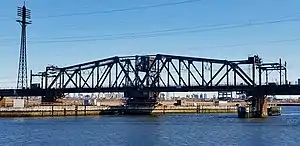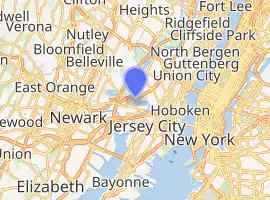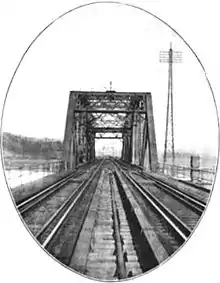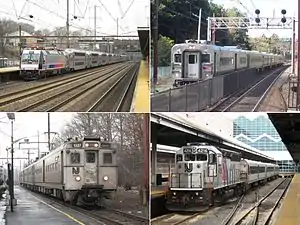Portal Bridge
The Portal Bridge is a two-track moveable swing-span railroad bridge over the Hackensack River in Kearny and Secaucus, New Jersey, United States, just west of Secaucus Junction. Owned and operated by Amtrak as part of the Northeast Corridor, and used by NJ Transit, it is considered the busiest train span in the Western Hemisphere,[1] carrying between 150,000 and 200,000 passengers per day[1][2][3] on approximately 450 daily trains (an average of one train every six minutes over a 24-hour period).[1]
Portal Bridge | |
|---|---|
 | |
| Coordinates | 40°45′13″N 74°5′41″W |
| Carries | Northeast Corridor |
| Crosses | Hackensack River |
| Locale | New Jersey Meadowlands |
| Owner | Amtrak |
| Characteristics | |
| Design | Pratt truss swing bridge |
| Material | Bessemer steel |
| Total length | 961 ft (293 m) |
| No. of spans | 6 deck girder + 1 swing span |
| Clearance below | 23 ft (7.0 m) |
| History | |
| Constructed by | Pennsylvania Steel Company |
| Inaugurated | 1910 |
| Location | |

| |
Originally opened in 1910,[3] the bridge was built by the Pennsylvania Railroad in conjunction with service to the newly constructed Pennsylvania Station in New York City. It is 961 feet long. The bridge clearance of 23 feet (7.0 m) requires it to swing open to allow even small commercial boats to pass underneath it. By the 2000s, the Portal Bridge was considered obsolete and train speeds are limited to 60 miles per hour (97 km/h).
Plans to replace the bridge is the first phase of the Gateway Project. As of March 2019, the estimated cost for replacing the bridge was at least $1.5 billion ($15.6 million per foot).[1][4] After initially refusing to provide any funding for the project, the Trump administration allowed the project to move forward in February 2020.[5][6] Funding would be shared by the federal government, the state of New Jersey and Amtrak. Bidding for construction is expected to begin in early 2021.[7] On January 12, 2021, the Federal Transit Administration awarded a $766.5 million grant to NJ Transit for the reconstruction of this bridge.[8]
Design and construction
The bridge was built by the Pennsylvania Railroad as part of its New York Tunnel Extension project, which also included the Sawtooth Bridges, North River Tunnels, and Manhattan Transfer station.

The Portal Bridge is a 961-foot (293 m) steel structure with masonry abutments. The bridge consists of a 300-foot (91 m) through-truss swing span and six 110-foot-long (34 m) open-deck girder approach spans (three on each side of the center span).[9](p8) The bridge itself is partially made of wood.[1]
Construction of the bridge was begun in August 1905, and the bridge was placed in service on November 27, 1910,[9](p8) based on bridge designs from the 1840s. The bridge was designed to last 100 years.[3] Overhead catenary to supply power to electric locomotives was installed in the 1930s.[9](p8) Some of the bridge machinery was updated in 1931. Minor repairs were made in the 1970s, and major repairs to structural, mechanical and electrical equipment were completed as part of Amtrak's Northeast Corridor Improvement Project between 1982 and 1984. In mid-2019 the bridge will undergo a timber replacement.[10]
Operation
Rail service
Rail traffic is carried over the swing bridge when it is closed. Rail service is currently at capacity, having grown from 40,000 daily passengers in 2005[11] to 150,000 to 200,000 daily passengers in 2015[2][3] on approximately 450 daily trains[1] for Amtrak and New Jersey Transit.
As of 2020, Amtrak operated some 293 scheduled trains a week in both directions (about 42 per day) over this segment of the Northeast Corridor between Newark Penn Station and New York Penn Station. Five NJ Transit rail lines (Northeast Corridor Line, North Jersey Coast Line, Morris and Essex Lines, Montclair-Boonton Line, and Raritan Valley Line) with 388 trains use the bridge each weekday in both directions.
River traffic
River traffic along the Hackensack River can flow under the swing bridge when it is open. Schedules prohibit the Portal Bridge from opening weekdays 5 am to 10 am and 3 pm to 8 pm, during peak commuter travel periods over the bridge. At other times, the bridge opens on signal if a vessel gives two-hour notice, also in the hours leading up to peak periods, which can affect train schedules.[12][13]
When closed to river traffic, the bridge bears upon six wedge blocks. Two blocks are at each end of the bridge while two more sit adjacent to the center of the bridge. After the wedges are withdrawn the center-bearing supports the structure as the bridge is opened and returns it to its closed position once the river traffic has passed through one or both of the navigation channels.
As of 2015, the only regularly scheduled commercial traffic on the river is a barge full of sludge[3] traveling from Bergen County Utilities Authority complex in Little Ferry to a sewage treatment plant in Newark.[1] For the last four months of 2014, of the 90 times the bridge was opened, 75 were to provide service to the sludge barge.[3] The bridge has caused numerous delays in train service in order to allow for river service, though Amtrak does not keep specific records of delays.[3] All sludge has been trucked since 2016.[14]
Operational issues
The Portal Bridge has been called the Achilles' heel of the Northeast Corridor for several reasons.[2] Currently, the bridge limits train speeds to 60 mph (97 km/h)[1][2][3] The bridge's lowest beams are just 23 feet (7.0 m) above the surface of the Hackensack River at high tide.[1] As a result, the bridge often has to be opened to allow commercial boats to pass underneath it, which causes more delays for both train and boat traffic.[2][3] The Portal Bridge fails to close properly one out of seven times it opens, because the rails can fail to lock into place. In extreme cases, rail crews must bang the rails into place with sledgehammers before trains can cross.[15][16] One report in 2019 estimated that the North River Tubes and the Portal Bridge contributed to 2,000 hours of delays between 2014 and 2018.[17]
Accidents and incidents
1996 derailment
The bridge was site of a derailment on November 23, 1996[9] when the swing bridge failed to close properly. Amtrak's Fast Mail Train No. 12, with twelve passenger and mail coaches pulled by two locomotives on a Washington-to-Boston run with 88 passengers and 20 crew members, derailed as it reached the bridge. It sideswiped an oncoming passenger train, but continued across the bridge, prevented from plunging through the trestles into the river by guide rails that parallel the main tracks. Then its twin locomotives, a baggage car, and three passenger coaches plunged over an embankment.[9](pp1–5) There were no deaths; thirty-four people were hospitalized.[18] The reason for the derailment was that a rail was 5 inches higher than it was supposed to be, and acted as a ramp.[9][19] As a result of the derailment, the maximum speed on the bridge was lowered to 60 mph (97 km/h),[1] making the bridge a choke point for the entire Northeast Corridor. The cost of the derailment was estimated at $3.6 million.[9](p8)
Fires
On May 13, 2005, the bridge caught on fire. NJ Transit engineers believe that the 13kV overhead electrical wires overheated, sending shards of metal towards the creosote-covered wooden fenders at the base of the bridge.[20] The immediate result of the fire was to block all traffic until the next morning.[11] The cost of the incident was $5 million.[21]
On August 4, 2014, the bridge caught on fire, interrupting rail traffic for half an hour.[22][23]
Replacement
Planning
The bridge requires millions of dollars of yearly maintenance.[11] According to several officials, the bridge is considered a "choke-point" which reduces the potential speed and capacity of the line. These officials include U.S. Sen. Bob Menendez (NJ);[2] Drew Galloway, Amtrak Assistant V.P. of Planning and Development[1] and the chief of Planning and Performance for the Northeast Corridor;[2] New Jersey Transit Executive Director Richard Sarles.[11][24]
In December 2008, the Federal Railroad Administration approved a $1.34 billion project to replace the Portal Bridge with two new bridges:[1] a three-track bridge to the north, and a two-track bridge to the south.[21] The new bridges were then scheduled to be completed in 2017, at which time the Portal Bridge was to be dismantled. In course of design work the number of tracks on the north bridge has been reduced from three to two.[25]
Design work progressed in 2009 and 2010. In 2009, New Jersey applied for $38.5 million in funding for the replacement from the American Recovery and Reinvestment Act of 2009.[26] On January 28, 2010, the federal funds were released as a TIGER grant[27] as part of a larger package of $112 million for the entire Northeast Corridor.[28] The $38.5 million in federal funds were intended for final design for the new bridge.[28][29][30]
The original timeline for the project called for construction of the new bridge to begin in 2010, with the bridge replacement to be complete by 2017. However, partly due to cancellation of the Access to the Region's Core project in 2010, as well as funding issues, this original plan was reduced to a single two-track bridge constructed north of the current bridge with room for a new bridge south of the current bridge left open to follow.[1] In 2014, design work for the new Portal Bridge North had been completed.[1] The proposed Portal Bridge North would be a fixed span rising over 50 feet (15 m) above mean water level, and would allow train speeds of at least 90 mph (140 km/h).[2] The new bridge would also be a part of the Amtrak Gateway Project—itself a partial replacement of the Access to the Region's Core—estimated to cost $13.5 billion.[31][32][33]
Preliminary site-preparation work for one span, Portal Bridge North, began in October 2017 and was expected to be complete in 2019.[34][35][36]
Delays
Progress on the Portal Bridge North has stalled due to funding. In April 2011, Amtrak applied for federal funding of $570 million for construction, with New Jersey expected to commit $150 million.[37][38] As of 2014, however, the project was lacking $940 million in funding.[1][2] The Port Authority of New York and New Jersey planned to contribute $300 million to the project.[39][40][41]
Funding
In October 2015, a $16 million TIGER grant was awarded for use to support early construction activities such as realignment of a 138kV transmission monopole, constructing a temporary fiber optic cable pole line, building a finger pier construction access structure, a service access road and a 560-foot retaining wall.[42][43] The work was completed in February 2019.[44][45]
As of 2016, the expected schedule was for engineering phase to begin in 2017 and revenue service to start in 2024.[46] In May 2017, NJ Transit awarded a contract to carry out this work.[47] In June 2017, the Gateway Development Corporation formally applied for federal funding for the project.[48] The Federal Transit Administration (FTA) approved the Environmental Impact Statement for the replacement bridge in August 2017.[49] Construction on the first of two replacement bridges began in October 2017.[35] Amtrak has estimated the cost of the bridge's replacement to be $1.5 billion.[34]
Jersey City, which owns a 14-acre parcel originally earmarked for preservation and recreation, will sell it to make way for construction of the bridge.[50]
In June 2018, the State of New Jersey approved $600 million in bonds to finance the project.[51][52][53] Despite state funding, the federal government withheld funds for the project.[54][55] On June 24, 2019, the state governments of New York and New Jersey passed legislation to create the bi-state Gateway Development Commission, whose job it is to oversee the planning, funding, and construction of the rail tunnels and bridges of Gateway Program.[56] In September 2019, NJ Transit submitted a revised plan to the federal government clarifying the "local" contribution, which includes funding from Pennsylvania, New Jersey, New York, and Amtrak.[57]
On February 10, 2020, the replacement project was upgraded to "medium-high" priority by the FTA, thereby becoming eligible for funding under the Capital Investment Grants Program.[58][6] Despite his skepticism of the Gateway Program, President Donald Trump signaled that he would not stand in the way of the Portal Bridge Replacement Project after dinner with New Jersey Governor Phil Murphy.[59] In early July 2020, the FTA approved $767 million in funding for the project. In late May, Amtrak received $55 million from the same agency for the replacement bridge.[60]
See also
References
- McGeehan, Patrick (September 25, 2014). "104-Year-Old Portal Bridge Presents $900 Million Problem for Rail Commuters". The New York Times. Retrieved April 21, 2015.
- Porter, David (November 15, 2014). "New Jersey's Portal Bridge, bane of the Northeast Corridor, is due for upgrade". The Washington Post. Retrieved April 21, 2015.
- Maag, Christopher (February 21, 2015). "When Bergen County sludge meets rusty Amtrak bridge, both sides lose". The Record (Bergen County). Retrieved April 21, 2015.
- "Portal Bridge Replacement Project". Amtrak: The Northeast Corridor. Retrieved June 18, 2018.
- Young, Elise (March 15, 2019). "Portal Bridge's Reign of Misery Ending for NYC-Area Train Riders". Bloomberg.
- Higgs, Larry (February 10, 2020). "Portal Bridge clears last major hurdle before the federal dollars can flow". NJ.com. Retrieved February 11, 2020.
- https://www.nj.com/news/2020/07/portal-bridge-the-bane-of-nj-transit-riders-is-finally-going-to-be-replaced.html
- "USDOT announces $766.5 million grant agreement to NJ Transit for Portal North Bridge Project". www.masstransitmag.com. January 12, 2021. Retrieved January 18, 2021.
- Derailment of Amtrak Train No. 12 and Sideswipe of Amtrak No. 79 on Portal Bridge Near Secaucus, New Jersey, November 23, 1996 (Report). Washington, D.C.: National Transportation Safety Board. 1997.
- Hutter, David (May 14, 2019). "Amtrak, NJ Transit invest $31M in Northeast Corridor". NJBIZ. Retrieved July 26, 2019.
- McGeehan, Patrick (May 19, 2005). "Repairing New Jersey Bridge May Take a Year, Amtrak Says". The New York Times.
- 33 CFR 117.723
- Higgs, Larry (February 19, 2020). "The Portal Bridge will no longer open during rush hour. Your commute is grateful". NJ.com. Retrieved December 4, 2020.
- Bridge of lies: Amtrak's dumb Portal Bridge plan is a weak link in overblown Gateway, Daily News Editorial, June 18, 2018
- "What the heck is the Portal Bridge and why does it keep getting stuck open?". NJ.com. Retrieved July 7, 2018.
- Davidson, Cameron. "The Tunnel That Could Break New York". Politico. Retrieved July 7, 2018.
- "How bad are delays caused by North River Tunnel and Portal Bridge? 2,000 lost hours bad". www.MassTransitMag.com. Retrieved July 26, 2019.
- McFadden, Robert D. (November 25, 1996). "Broken Bars on Drawbridge Are Blamed in Amtrak Crash". The New York Times. Retrieved February 9, 2011.
- "America's ageing infrastructure: The Achilles' heel of the Northeast Corridor". Gulliver. The Economist. Washington, D.C. October 21, 2014. Retrieved April 21, 2015.
- McGeehan, Patrick (May 14, 2005). "Trains Crawl Back Into Service After Kearny Bridge Fire". The New York Times. Retrieved April 21, 2015.
- Belsen, Ken (December 31, 2008). "Approval Given for New Jersey Rail Bridges". The New York Times. Retrieved February 8, 2011.
- Kunzmann, Kevin (August 4, 2014). "Fire on Portal Bridge shuts down NJ Transit". Retrieved October 16, 2018.
- Kunzmann, Kevin (August 4, 2014). "Fire on Portal Bridge shuts down NJ Transit". The Star-Ledger.
- "NJ moves to replace key N.E. Corridor rail bridge". philly.com. Archived from the original on August 28, 2009. Retrieved May 14, 2015.
- "Portal Bridge Replacement Project". Amtrak: The Northeast Corridor.
- "Feds Open 'Portal' to Expansion of NJ Transit's Network". Tri-State Transportation Campaign. January 8, 2009.
- "High-Speed Intercity Passenger Rail (HSIPR) Program" (PDF). Archived from the original (PDF) on January 5, 2011. Retrieved February 10, 2011.
- Frassinelli, Mike (January 28, 2010). "NJ Transit announces $38.5M for Portal Bridge project, names executive director". The Star-Ledger. Retrieved February 8, 2011.
- "Portal Bridge Capacity Enhancement". Amtrak, New Jersey Transit, United States Department of Transportation. Archived from the original on February 8, 2011. Retrieved February 8, 2011.
- Whiten, Jon (February 8, 2010). "Advocates Want Bike/Ped Path as Part of Portal Bridge Project". Jersey City Independent. Archived from the original on July 11, 2011. Retrieved February 8, 2011.
- Frassinelli, Mike (February 6, 2011). "N.J. senators, Amtrak official to announce new commuter train tunnel project across the Hudson". The Star-Ledger. Retrieved February 7, 2011.
- "Gateway Project" (PDF). Amtrak. February 2011. Archived from the original (PDF) on February 7, 2011. Retrieved February 7, 2011.
- Fleisher, Liza; Grossman, Andrew (February 8, 2011). "Amtrak's Plan For New Tunnel Gains Support". The Wall Street Journal. Retrieved February 8, 2011.
- Russ, Hilary (October 13, 2017). "Construction starts on New Jersey bridge, a step to fixing region's rail". Reuters.
- Tate, Curtis (October 8, 2018). "There's no new Portal Bridge yet. But smaller pieces are falling into place". Retrieved October 16, 2018.
- "Work on New Portal Bridge Reaches Milestone, Federal Funding Not Yet in Place". NJ Spotlight. October 26, 2018.
- "Amtrak Seeks $1.3 billion for Gateway Project and Next-Generation High-Speed Rail on NEC". Amtrak. April 4, 2011. Retrieved April 8, 2011.
- Jackson, Herb (April 4, 2011). "Amtrak seeking $1.3B for Hudson River tunnel planning, bridge replacement". The Record (New Jersey). Archived from the original on May 16, 2011. Retrieved April 10, 2011.
- "Port Authority Makes Largest Financial Commitment To The Gateway Program, One Of The Nation's Most Important Infrastructure Projects" (Press release). The Port Authority of New York & New Jersey. October 20, 2016. Retrieved October 16, 2018.
- "Port Authority commits money to replace Portal Bridge". Associated Press. October 21, 2016. Retrieved October 16, 2018.
- "Port Authority approves funds to replace Portal Bridge". Crain's New York Business. October 21, 2016.
- Maag, Christopher. "NJ Transit gets $16M grant for rail bridge replacement". NorthJersey.com. Retrieved October 27, 2015.
- "$16M federal grant will help replace Portal Bridge". NJ.com. Retrieved October 27, 2015.
- "StackPath". www.masstransitmag.com.
- Higgs, Larry (February 23, 2019). "The rusty old bridge that kills your NJ Transit commute is very close to being replaced". NJ.com.
- "Portal North Bridge Project Hudson County, New Jersey New Starts Project Development Information" (PDF). FTA. June 2016. Retrieved December 10, 2016.
- "NJ TRANSIT Board Awards Construction Contract For Portal Bridge Project" (Press release). NJ Transit. Retrieved October 1, 2016.
- Rubinstein, Dana (June 1, 2017). "Gateway builders forge ahead amid Trump uncertainty". Politico. Retrieved June 2, 2017.
- Salant, Jonathan D. (August 2, 2017). "Portal Bridge project clears another hurdle". NJ Advance Media. Retrieved August 30, 2017.
- Sullivan, Al (February 1, 2019). "Paving the way for Gateway project". hudsonreporter.com.
- "Floating a $600 Million Bond Issue to Build New Portal Bridge". NJ Spotlight. June 12, 2018. Retrieved August 13, 2018.
- "Will new state funding move the feds to chip in for Portal Bridge?". North Jersey. Retrieved August 13, 2018.
- "NJ Transit board approves $600M bond to replace Portal Bridge". NJBIZ. Retrieved August 13, 2018.
- Munoz, Daniel J. (September 4, 2018). "First phase of Gateway project 'shovel-ready,' Murphy says". NJBIZ.
- Reitmeyer, John (September 5, 2018). "Talk About Stalled Trans-Hudson Tunnel, Portal Bridge Takes on Ominous Tone". NJ Spotlight.
- Wanek-Libman, Mischa (June 24, 2019). "Bi-state legislation passed to establish Gateway Development Commission". Mass Transit Magazine. Retrieved June 24, 2019.
- "NJ Transit Revises Financial Plan for Portal North Bridge". NJ Spotlight. September 16, 2019.
- "New Jersey's Portal Bridge OK'd For Federal Funds, But Gateway Project Doesn't Make Cut". CBSNewYork-Associated Press. February 11, 2020. Retrieved February 11, 2020.
- Knapp, Krystal (June 15, 2020). "NJ governor: Trump's approval of Portal Bridge replacement a 'huge victory'". Traffic and Transit. Planet Princeton. Retrieved July 12, 2020.
- Cuenca, Oliver (July 1, 2020). "US FTA approves $US 767m funding for New Jersey bridge". North America. International Railway Journal. Retrieved July 12, 2020.
External links
- Official website
- "The Portal Bridge Link" - Enhancement project newsletter, January 2007
- NTSB Special Investigation Report regarding 1997 derailment
- Movable Railroad Bridges of New Jersey-photo catalog
- Portal Bridge photos and notes
- FRA ROD
